|
|
| Ex caſtro Tiberis. |
Cœleſtinus. ij. |
Typhernas. |
| 165 |
1. From a castle of the Tiber |
Celestine II (1143–1144) |
Guido de Castello |
An inhabitant of Tifernum.
Celestine II was born in Città di Castello (formerly called Tifernum-Tiberinum), on the banks of the Tiber.[14] |
|
| Inimicus expulſus. |
Lucius. ij. |
De familia Caccianemica. |
| 166 |
2. Enemy expelled |
Lucius II (1144–1145) |
Gherardo Caccianemici del Orso |
Of the Caccianemici family.
According to Wyon, this motto refers to Lucius II's family name, Caccianemici; in Italian, “Cacciare” means “to drive out” and “nemici” means “enemies”.[15] While he has been traditionally viewed as being part of this family, it is doubtful whether he actually was; moreover, even if he actually belonged to that family, the atribution of the surname Caccianemici is certainly anachronistic.[16] |
|
| Ex magnitudine mõtis. |
Eugenius. iij. |
Patria Ethruſcus oppido Montis magni. |
| 167 |
3. From the great mountain |
Eugene III (1145–1153) |
Bernardo dei Pagnelli di Montemagno |
Tuscan by nation, from the town of Montemagno.
According to Wyon, the motto refers to Eugene III’s birthplace, “Montemagno.”[17] But actually he was born in Pisa in modest family.[18][19] |
|
| Abbas Suburranus. |
Anaſtaſius. iiij. |
De familia Suburra. |
| 168 |
4. Abbot from Subbura |
Anastasius IV (1153–1154) |
Corrado di Suburra |
From the Suburra family.[17] He was traditionally referred to as abbot of the canon regulars of St. Ruf in Avignon, but modern scholars have established that he actually belonged to the secular clergy.[20] |
|
| De rure albo. |
Adrianus. iiij. |
Vilis natus in oppido Sancti Albani. |
| 169 |
5. From the white countryside |
Adrian IV (1154–1159) |
Nicholas Breakspear |
Humbly born in the town of St. Albans.
Most likely a reference to Adrian IV's birthplace near St Albans, Hertfordshire.[21] |
|
| Ex tetro carcere. |
Victor. iiij. |
Fuit Cardinalis S. Nicolai in carcere Tulliano. |
|
6. Out of a loathsome prison. |
Victor IV, Antipope (1159–1164) |
Ottaviano Monticello |
He was a cardinal of St. Nicholas in the Tullian prison.
Victor IV may have held the title San Nicola in Carcere.[22] |
|
| Via Tranſtiberina. |
Calliſtus. iij. [sic] |
Guido Cremenſis Cardinalis S. Mariæ Tranſtiberim. |
|
7. Road across the Tiber. |
Callixtus III, Antipope (1168–1178) |
Giovanni di Strumi |
Guido of Crema, Cardinal of St. Mary across the Tiber.
Wyon reverses the names and order of Antipopes Callixtus III (John of Struma) and Paschal III (Guido of Crema). Paschal, not Callixtus, was born Guido of Crema and held the title of Santa Maria in Trastevere, to which the motto applies.[23] |
|
| De Pannonia Thuſciæ. |
Paſchalis. iij. [sic] |
Antipapa. Hungarus natione, Epiſcopus Card. Tuſculanus. |
|
8. From Tusculan Hungary. |
Paschal III, Antipope (1164–1168) |
Guido di Crema |
Antipope. A Hungarian by birth, Cardinal Bishop of Tusculum.
As noted above, this motto applies not to Paschal III, but to Callixtus III, who allegedly was Hungarian.[23]. However, Callixtus was Cardinal Bishop of Albano, not of Tusculum.[24] |
|
| Ex anſere cuſtode. |
Alexander. iij. |
De familia Paparona. |
| 170 |
9. From the guardian goose |
Alexander III (1159–1181) |
Rolando (or Orlando) of Siena |
Of the Paparoni family.
Alexander III may have been from the Bandinella family, which was afterwards known as the Paparona family, which featured a goose on its coat of arms. There is debate whether Alexander III was in fact of that family.[25] |
|
| Lux in oſtio. |
Lucius. iij. |
Lucenſis Card. Oſtienſis. |
| 171 |
10. A light in the door |
Lucius III (1181–1185) |
Ubaldo Allucingoli |
A Luccan Cardinal of Ostia.
The motto is a wordplay on "Lucius" or "Lucca" and "Ostia".[26] |
|
| Sus in cribro. |
Vrbanus. iij. |
Mediolanenſis, familia cribella, quæ Suem pro armis gerit. |
| 172 |
11. Pig in a sieve |
Urban III (1185–1187) |
Umberto Crivelli |
A Milanese, of the Cribella (Crivelli) family, which bears a pig for arms.
Urban III's family name Crivelli means "a sieve" in Italian; his arms included a sieve and two pigs.[27] |
|
| Enſis Laurentii. |
Gregorius. viij. |
Card. S. Laurentii in Lucina, cuius inſignia enſes falcati. |
| 173 |
12. The sword of Lawrence |
Gregory VIII (1187) |
Alberto De Morra |
Cardinal of St. Lawrence in Lucina, of whom the arms were curved swords.
Gregory VIII was Cardinal of St. Lawrence and his arms featured crossed swords.[28] |
|
| De Schola exiet.[29] |
Clemens. iij. |
Romanus, domo Scholari. |
| 174 |
13 He will come from school |
Clement III (1187–1191) |
Paolo Scolari |
A Roman, of the house of Scolari.
The motto is a play on words on Clement III's surname.[30] |
|
| De rure bouenſi. |
Cœleſtinus. iij. |
Familia Bouenſi. |
| 175 |
14. From cattle country |
Celestine III (1191–1198) |
Giacinto Bobone |
Bovensis family.
The reference to cattle is a wordplay on Celestine III's surname, Bobone.[31] |
|
| Comes Signatus. |
Innocentius. iij. |
Familia Comitum Signiæ. |
| 176 |
15. Designated count |
Innocent III (1198–1216) |
Lotario dei Conti di Segni |
Family of the Counts of Signia (Segni)
The motto is a direct reference to Innocent III's family name.[32] |
 |
| Canonicus de latere. |
Honorius. iij. |
Familia Sabella, Canonicus S. Ioannis Lateranensis. |
| 177 |
16. Canon from the side |
Honorius III (1216–1227) |
Cencio Savelli |
Savelli family, canon of St. John Lateran
The claim in Wyon that Honorius III was a canon of St. John Lateran is contested by some historians.[30] |
 |
| Auis Oſtienſis. |
Gregorius. ix. |
Familia Comitum Signiæ Epiſcopus Card. Oſtienſis. |
| 178 |
17. Bird of Ostia |
Gregory IX (1227–1241) |
Ugolino dei Conti di Segni |
Family of the Counts of Segni, Cardinal Bishop of Ostia.
Before his election to the papacy, Ugolino dei Conti was the Cardinal Bishop of Ostia, and his coat of arms depict an eagle.[33] |
 |
| Leo Sabinus. |
Cœleſtinus iiij. |
Mediolanenſis, cuius inſignia Leo, Epiſcopus Card. Sabinus. |
| 179 |
18. Sabine Lion |
Celestine IV (1241) |
Goffredo Castiglioni |
A Milanese, whose arms were a lion, Cardinal Bishop of Sabina.
Celestine IV was Cardinal Bishop of Sabina and his armorial bearing had a lion in it.[34] |
 |
| Comes Laurentius. |
Innocentius iiij. |
domo flisca, Comes Lauaniæ, Cardinalis S. Laurentii in Lucina. |
| 180 |
19. Count Lawrence |
Innocent IV (1243–1254) |
Sinibaldo Fieschi |
Of the house of Flisca (Fieschi), Count of Lavagna, Cardinal of St. Lawrence in Lucina.
The motto, as explained in Wyon, is a reference to Innocent IV's father, the Count of Lavagna, and his title Cardinal of St. Lawrence in Lucina.[34] |
 |
| Signum Oſtienſe. |
Alexander iiij. |
De comitibus Signiæ, Epiſcopus Card. Oſtienſis. |
| 181 |
20. Sign of Ostia |
Alexander IV (1254–1261) |
Renaldo dei Signori di Ienne |
Of the counts of Segni, Cardinal Bishop of Ostia.
The motto refers to Alexander IV's being Cardinal Bishop of Ostia and member of the Conti-Segni family.[34] |
 |
| Hieruſalem Campanię. |
Vrbanus iiii. |
Gallus, Trecenſis in Campania, Patriarcha Hieruſalem. |
| 182 |
21. Jerusalem of Champagne |
Urban IV (1261–1264) |
Jacques Pantaleon |
A Frenchman, of Trecae (Troyes) in Champagne, Patriarch of Jerusalem.
The motto refers to Urban IV's birthplace of Troyes, Champagne, and title Patriarch of Jerusalem.[35] |
 |
| Draco depreſſus. |
Clemens iiii. |
cuius inſignia Aquila vnguibus Draconem tenens. |
| 183 |
22. Dragon pressed down |
Clement IV (1265–1268) |
Guido Fulcodi |
Whose badge is an eagle holding a dragon in his talons.
According some sources, Clement IV's coat of arms depicted an eagle clawing a dragon. Other sources indicate that it was instead six fleurs-de-lis.[36] |
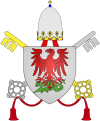 |
| Anguinus uir. |
Gregorius. x. |
Mediolanenſis, Familia vicecomitum, quæ anguẽ pro inſigni gerit. |
| 184 |
23. Snaky man |
Gregory X (1271–1276) |
Teobaldo Visconti |
A Milanese, of the family of Viscounts (Visconti), which bears a snake for arms.
The Visconti coat of arms had a large serpent devouring a male child feet first; sources conflict as to whether Gregory X used this for his papal arms.[37] |
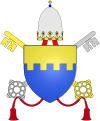 |
| Concionator Gallus. |
Innocentius. v. |
Gallus, ordinis Prædicatorum. |
| 185 |
24. French Preacher |
Innocent V (1276) |
Pierre de Tarentaise |
A Frenchman, of the Order of Preachers.
Innocent V was born in what is now south-eastern France and was a member of the order of Preachers.[38] |
 |
| Bonus Comes. |
Adrianus. v. |
Ottobonus familia Fliſca ex comitibus Lauaniæ. |
| 186 |
25. Good Count |
Adrian V (1276) |
Ottobono Fieschi |
Ottobono, of the Fieschi family, from the counts of Lavagna.
The Fieschi family were counts of Lavagna and a wordplay on "good" can be made with Adrian V's first name, Ottobono.[39] |
 |
| Piſcator Thuſcus. |
Ioannes. xxi. |
antea Ioannes Petrus Epiſcopus Card. Tuſculanus. |
| 187 |
26. Tuscan Fisherman |
John XXI (1276–1277) |
Pedro Julião |
Formerly John Peter, Cardinal Bishop of Tusculum.
John XXI had been the Cardinal Bishop of Tusculum, and shared his first name with Saint Peter, a fisherman.[40] |
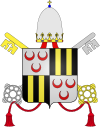 |
| Roſa compoſita. |
Nicolaus. iii. |
Familia Vrſina, quæ roſam in inſigni gerit, dictus compoſitus. |
| 188 |
27. Composite Rose |
Nicholas III (1277–1280) |
Giovanni Gaetano Orsini |
Of the Ursina (Orsini) family, which bears a rose on its arms, called 'composite'.
Nicholas III bore a rose in his coat of arms.[40] |
 |
| Ex teloneo liliacei Martini. |
Martinus. iiii. |
cuius inſignia lilia, canonicus, & theſaurarius S. Martini Turonen[sis]. |
| 189 |
28. From the tollhouse of Martin of the lilies |
Martin IV (1281–1285) |
Simone de Brion |
Whose arms were lilies, canon and treasurer of St. Martin of Tours.
Martin IV was Canon and Treasurer at the Church of St. Martin in Tours, France.[41] Wyon's assertion that his arms featured lilies is incorrect.[42] |
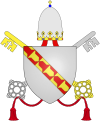 |
| Ex roſa leonina. |
Honorius. iiii. |
Familia Sabella inſignia roſa à leonibus geſtata. |
| 190 |
29. Out of the leonine rose |
Honorius IV (1285–1287) |
Giacomo Savelli |
Of the Sabella (Savelli) family, arms were a rose carried by lions.
Honorius IV's coat of arms was emblazoned with two lions supporting a rose.[43] |
 |
| Picus inter eſcas. |
Nicolaus. iiii. |
Picenus patria Eſculanus.[44] |
| 191 |
30. Woodpecker between food |
Nicholas IV (1288–1292) |
Girolamo Masci |
A Picene by nation, of Asculum (Ascoli).
The motto is likely an obscure wordplay on Nicholas IV's birthplace in Ascoli, in Picenum.[43] |
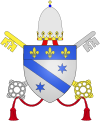 |
| Ex eremo celſus. |
Cœleſtinus. v. |
Vocatus Petrus de morrone Eremita. |
| 192 |
31. Raised out of the desert |
St. Celestine V (1294) |
Pietro Di Murrone |
Called Peter de Morrone, a hermit.
Prior to his election, Celestine V was a hermit (eremita, literally a dweller in the eremus, or desert).[45] |
 |
| Ex undarũ bn̑dictione. |
Bonifacius. viii. |
Vocatus prius Benedictus, Caetanus, cuius inſignia undæ. |
| 193 |
32. From the blessing of the waves |
Boniface VIII (1294–1303) |
Benedetto Caetani |
Previously called Benedict, of Gaeta, whose arms were waves.
Boniface VIII's coat of arms had a wave through it. Also a play on words, referring to the pope's Christian name, "Benedetto."[46] |
 |
| Concionator patereus. [sic] |
Benedictus. xi. |
qui uocabatur Frater Nicolaus, ordinis Prædicatorum. |
| 194 |
33. Preacher From Patara |
Benedict XI (1303–1304) |
Nicholas Boccasini |
Who was called Brother Nicholas, of the order of Preachers.
Benedict XI belonged to the Order of Preachers, and his namesake Saint Nicholas was from Patara. O'Brien notes, "Everything leads us to suspect that the author and interpreter of the prophecy is one and the same person. The pretended interpreter who knew that Patare was the birthplace of St. Nicholas forgot that others may not be aware of the fact, and that therefore the explanation would be thrown away on them."[13] |
 |
| De feſſis aquitanicis. |
Clemens V. |
natione aquitanus, cuius inſignia feſſæ erant. |
| 195 |
34. From the fesses of Aquitaine |
Clement V (1305–1314) |
Bertrand de Got |
An Aquitanian by birth, whose arms were fesses.
Clement V was Bishop of St-Bertrand-de-Comminges in Aquitaine, and eventually became Archbishop of Bordeaux, also in Aquitaine. His coat of arms displays three horizontal bars, known in heraldry as fesses.[47] |
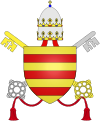 |
| De ſutore oſſeo. |
Ioannes XXII. |
Gallus, familia Oſſa, Sutoris filius. |
| 196 |
35. From a bony cobbler |
John XXII (1316–1334) |
Jacques Duese |
A Frenchman, of the Ossa family, son of a cobbler.
John XXII's family name was Duèze or D'Euse, the last of which might be back-translated into Latin as Ossa ("bones"), the name Wyon gives. The popular legend that his father was a cobbler is dubious.[48] |
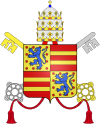 |
| Coruus ſchiſmaticus. |
Nicolaus V. |
qui uocabatur F. Petrus de corbario, contra Ioannem XXII. Antipapa Minorita. |
|
36. Schismatic crow |
Nicholas V, Antipope (1328–1330) |
Pietro Rainalducci di Corvaro |
Who was called Brother Peter of Corbarium (Corvaro), the Minorite antipope opposing John XXII.
The motto is a play on words, referring to Pietro di Corvaro's last name.[49] |
|
| Frigidus Abbas. |
Benedictus XII. |
Abbas Monaſterii fontis frigidi. |
| 197 |
37. Cold abbot |
Benedict XII (1334–1342) |
Jacques Fournier |
Abbot of the monastery of the cold spring.
Benedict XII was an abbot in the monastery of Fontfroide ("cold spring").[50] |
 |
| De roſa Attrebatenſi. |
Clemens VI. |
Epiſcopus Attrebatenſis, cuius inſignia Roſæ. |
| 198 |
38. From the rose of Arras |
Clement VI (1342–1352) |
Pierre Roger |
Bishop of Arras, whose arms were roses.
Clement VI was Bishop of Arras (in Latin, Episcopus Attrebatensis) and his armorial bearings were emblazoned with six roses.[51] |
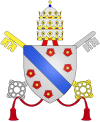 |
| De mõtibus Pãmachii. |
Innocentius VI. |
Cardinalis SS. Ioannis & Pauli. T. Panmachii, cuius inſignia ſex montes erant. |
| 199 |
39. From the mountains of Pammachius |
Innocent VI (1352–1362) |
Etienne Aubert |
Cardinal of Saints John and Paul, Titulus of Pammachius, whose arms were six mountains.
Innocent VI was Cardinal Priest of Pammachius. Wyon and Panvinio describe his arms as depicting six mountains, though other sources do not.[52] |
 |
| Gallus Vicecomes. |
Vrbanus V. |
nuncius Apoſtolicus ad Vicecomites Mediolanenſes. |
| 200 |
40. French viscount |
Urban V (1362–1370) |
Guglielmo De Grimoard |
Apostolic nuncio to the Viscounts of Milan.
Urban V was French.[53] Wyon indicates he was Apostolic Nuncio to the Viscounts of Milan.[54] |
 |
| Nouus de uirgine forti. |
Gregorius XI. |
qui uocabatur Petrus Belfortis, Cardinalis S. Mariæ nouæ. |
| 201 |
41. New man from the strong virgin |
Gregory XI (1370–1378) |
Pierre Roger de Beaufort |
Who was called Peter Belfortis (Beaufort), Cardinal of New St. Mary's.
The motto refers to Gregory XI's surname and his title Cardinal of Santa Maria Nuova.[55] |
 |
| Decruce Apoſtolica. [sic] |
Clemens VII. |
qui fuit Preſbyter Cardinalis SS. XII. Apoſtolorũ cuius inſignia Crux. |
|
42. From the apostolic cross |
Clement VII, Antipope (1378–1394) |
Robert, Count of Geneva |
Who was Cardinal Priest of the Twelve Holy Apostles, whose arms were a cross.
Clement VII's coat of arms showed a cross and he held the title Cardinal Priest of the Twelve Holy Apostles.[56] |
.svg/100px-C_o_a_Clemente_VII_(Avignone).svg.png) |
| Luna Coſmedina. |
Benedictus XIII. |
antea Petrus de Luna, Diaconus Cardinalis S. Mariæ in Coſmedin. |
|
43. Cosmedine moon. |
Benedict XIII, Antipope (1394–1423) |
Peter de Luna |
Formerly Peter de Luna, Cardinal Deacon of St. Mary in Cosmedin.
The motto refers to Benedict XIII's surname and title.[57] |
.svg/100px-C_o_a_Benedetto_XIII_(Avignone).svg.png) |
| Schiſma Barchinoniũ. |
Clemens VIII. |
Antipapa, qui fuit Canonicus Barchinonenſis. |
|
44. Schism of the Barcelonas |
Clement VIII, Antipope (1423–1429) |
Gil Sanchez Muñoz |
Antipope, who was a canon of Barcelona.[57] |
|
| De inferno prægnãti. |
Vrbanus VI. |
Neapolitanus Pregnanus, natus in loco quæ dicitur Infernus. |
| 202 |
45. From a pregnant hell. |
Urban VI (1378–1389) |
Bartolomeo Prignano |
The Neapolitan Prignano, born in a place which is called Inferno.
Urban VI's family name was Prignano or Prignani, and he was native to a place called Inferno near Naples.[58] |
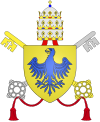 |
| Cubus de mixtione. |
Bonifacius. IX. |
familia tomacella à Genua Liguriæ orta, cuius inſignia Cubi. |
| 203 |
46. Square of mixture |
Boniface IX (1389–1404) |
Pietro Tomacelli |
Of the Tomacelli family, born in Genoa in Liguria, whose arms were cubes.
Boniface IX's coat of arms includes a bend checky — a wide stripe with a checkerboard pattern.[59] |
 |
| De meliore ſydere. |
Innocentius. VII. |
uocatus Coſmatus de melioratis Sulmonenſis, cuius inſignia ſydus. |
| 204 |
47. From a better star |
Innocent VII (1404–1406) |
Cosmo Migliorati |
Called Cosmato dei Migliorati of Sulmo, whose arms were a star.
The motto is a play on words, "better" (melior) referring to Innocent VII's last name, Migliorati (Meliorati). There is a shooting star on his coat of arms.[59] |
 |
| Nauta de Ponte nigro. |
Gregorius XII. |
Venetus, commendatarius eccleſiæ Nigropontis. |
| 205 |
48. Sailor from a black bridge |
Gregory XII (1406–1415) |
Angelo Correr |
A Venetian, commendatary of the church of Negroponte.
Gregory XII was born in Venice (hence mariner) and was commendatary of Chalkis, then called Negropont.[60] |
 |
| Flagellum ſolis. |
Alexander. V. |
Græcus Archiepiſcopus Mediolanenſis, inſignia Sol. |
|
49. Whip of the sun |
Alexander V, Antipope (1409–1410) |
Petros Philarges |
A Greek, Archbishop of Milan, whose arms were a sun.
Alexander V's coat of arms featured a sun, the wavy rays may explain the reference to a whip.[61] |
.svg/100px-C_o_a_Alexandre_V_(Pisa).svg.png) |
| Ceruus Sirenæ. |
Ioannes XXIII. |
Diaconus Cardinalis S. Euſtachii, qui cum ceruo depingitur, Bononiæ legatus, Neapolitanus. |
|
50. Stag of the siren |
John XXIII, Antipope (1410–1415) |
Baldassarre Cossa |
Cardinal Deacon of St. Eustace, who is depicted with a stag; legate of Bologna, a Neapolitan.
John XXIII was a cardinal with the title of St. Eustachius, whose emblem is a stag, and was originally from Naples, which has the emblem of the siren.[61] |
|
| Corona ueli aurei. |
Martinus V. |
familia colonna, Diaconus Cardinalis S. Georgii ad uelum aureum. |
| 206 |
51. Crown of the golden curtain |
Martin V (1417–1431) |
Oddone Colonna |
Of the Colonna family, Cardinal Deacon of St. George at the golden curtain.
The motto is a reference to Martin V's family name and cardinal title of San Giorgio in Velabro.[62]. |
 |
| Lupa Cœleſtina, |
Eugenius. IIII. |
Venetus, canonicus antea regularis Cœleſtinus, & Epiſcopus Senẽſis. |
| 207 |
52. Heavenly she-wolf |
Eugene IV (1431–1447) |
Gabriele Condulmaro |
A Venetian, formerly a regular Celestine canon, and Bishop of Siena.
Eugene IV belonged to the order of the Celestines and was the Bishop of Siena which bears a she-wolf on its arms.[63] |
 |
| Amator Crucis. |
Felix. V. |
qui uocabatur Amadæus Dux Sabaudiæ, inſignia Crux. |
|
53. Lover of the cross |
Felix V, Antipope (1439–1449) |
Amadeus, Duke of Savoy |
Who was called Amadeus, Duke of Savoy, arms were a cross.
The motto is a reference to Felix V's given name, Amadeus, and arms, which featured the cross of Savoy.[63] |
.svg/100px-C_o_a_Felice_V_(antipapa).svg.png) |
| De modicitate Lunæ. |
Nicolaus V. |
Lunenſis de Sarzana, humilibus parentibus natus. |
| 208 |
54. From the meanness of Luna |
Nicholas V (1447–1455) |
Tommaso Parentucelli |
A Lunese of Sarzana, born to humble parents.
Nicholas V was born in the diocese of Luni, the ancient name of which was Luna.[64] |
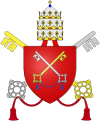 |
| Bos paſcens. |
Calliſtus. III. |
Hiſpanus, cuius inſignia Bos paſcens. |
| 209 |
55. Pasturing ox |
Callixtus III (1455–1458) |
Alfonso Borja |
A Spaniard, whose arms were a pasturing ox.
Callixtus III's coat of arms featured an ox.[64] |
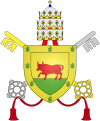 |
| De Capra & Albergo. |
Pius. II. |
Senenſis, qui fuit à Secretis Cardinalibus Capranico & Albergato. |
| 210 |
56. From a nanny-goat and an inn |
Pius II (1458–1464) |
Enea Silvio de Piccolomini |
A Sienese, who was secretary to Cardinals Capranicus and Albergatus.
Pius II was secretary to Cardinal Domenico Capranica and Cardinal Albergatti before he was elected Pope.[65] |
 |
| De Ceruo & Leone. |
Paulus. II. |
Venetus, qui fuit Commendatarius eccleſiæ Ceruienſis, & Cardinalis tituli S. Marci. |
| 211 |
57. From a stag and lion |
Paul II (1464–1471) |
Pietro Barbo |
A Venetian, who was commendatary of the church of Cervia, and Cardinal of the title of St. Mark.
The motto refers to his Bishopric of Cervia (punning on cervus, "a stag") and his Cardinal title of St. Mark (symbolized by a winged lion).[65] |
 |
| Piſcator minorita. |
Sixtus. IIII. |
Piſcatoris filius, Franciſcanus. |
| 212 |
58. Minorite fisherman |
Sixtus IV (1471–1484) |
Francesco Della Rovere |
Son of a fisherman, Franciscan.
Sixtus IV was born the son of a fisherman and a member of the Franciscans, also known as "Minorites" (which was founded in 1209, after Malachy's death.)[66] |
 |
| Præcurſor Siciliæ. |
Innocentius VIII. |
qui uocabatur Ioãnes Baptiſta, & uixit in curia Alfonſi regis Siciliæ. |
| 213 |
59. Precursor of Sicily |
Innocent VIII (1484–1492) |
Giovanni Battista Cibò |
Who was called John Baptist, and lived in the court of Alfonso, king of Sicily.
Innocent VIII was from Sicily. "Precursor" may be explained as an allusion to his birth name, after John the Baptist, the precursor of Christ.[67] |
 |
| Bos Albanus in portu. |
Alexander VI. |
Epiſcopus Cardinalis Albanus & Portuenſis, cuius inſignia Bos. |
| 214 |
60. Bull of Alba in the harbor |
Alexander VI (1492–1503) |
Rodrigo de Borgia |
Cardinal Bishop of Albano and Porto, whose arms were a bull.
In 1456, he was made a Cardinal and he held the titles of Cardinal Bishop of Albano and Porto, and his arms featured an ox.[67] |
 |
| De paruo homine. |
Pius. III. |
Senenſis, familia piccolominea. |
| 215 |
61. From a small man |
Pius III (1503) |
Francesco Todeschini Piccolomini |
A Sienese, of the Piccolomini family.
Pius III's family name was Piccolomini, from piccolo "small" and uomo "man".[68] |
 |
| Fructus Iouis iuuabit. |
Iulius. II. |
Ligur, eius inſignia Quercus, Iouis arbor. |
| 216 |
62. The fruit of Jupiter will help |
Julius II (1503–1513) |
Giuliano Della Rovere |
A Genoese, his arms were an oak, Jupiter's tree.
On Julius II's arms was an oak tree, which was sacred to Jupiter.[68] |
 |
| De craticula Politiana. |
Leo. X. |
filius Laurentii medicei, & ſcholaris Angeli Politiani. |
| 217 |
63. From a Politian gridiron |
Leo X (1513–1521) |
Giovanni de Medici |
Son of Lorenzo de' Medici, and student of Angelo Poliziano.
Leo X's educator and mentor was Angelo Poliziano. The “Gridiron” in the motto evidently refers to St. Lawrence, who was martyred on a gridiron. This is a rather elliptical allusion to Lorenzo the Magnificent, who was Giovanni’s father.[69] |
 |
| Leo Florentius. |
Adrian. VI. |
Florẽtii filius, eius inſignia Leo. |
| 218 |
64. Florentian lion |
Adrian VI (1522–1523) |
Adriaen Florenszoon Boeyens |
Son of Florentius, his arms were a lion.
Adrian VI's coat of arms had two lions on it, and his name is sometimes given as Adrian Florens, or other variants, from his father's first name Florens (Florentius).[70] |
 |
| Flos pilei ægri. |
Clemens. VII. |
Florentinus de domo medicea, eius inſignia pila, & lilia. |
| 219 |
65. Flower of the sick man's pill[71] |
Clement VII (1523–1534) |
Giulio de Medici |
A Florentine of the Medicean house, his arms were pill-balls and lilies.
The Medici coat of arms was emblazoned with six medical balls. One of these balls, the largest of the six, was emblazoned with the Florentine lily.[72] |
 |
| Hiacinthus medicorũ. |
Paulus. III. |
Farneſius, qui lilia pro inſignibus geſtat, & Card. fuit SS. Coſme, & Damiani. |
| 220 |
66. Hyacinth of the physicians |
Paul III (1534–1549) |
Alessandro Farnese |
Farnese, who bore lilies for arms, and was Cardinal of Saints Cosmas and Damian.
According to some sources, Paul III's coat of arms were charged with hyacinths, and he was cardinal of Saints Cosmas and Damian, both doctors.[73] |
 |
| De corona montana. |
Iulius. III. |
antea uocatus Ioannes Maria de monte. |
| 221 |
67. From the mountainous crown |
Julius III (1550–1555) |
Giovanni Maria Ciocchi del Monte |
Formerly called Giovanni Maria of the Mountain (de Monte)
His coat of arms showed mountains and laurel crowns (chaplets).[74] |
 |
| Frumentum flocidum. [sic] |
Marcellus. II. |
cuius inſignia ceruus & frumẽtum, ideo floccidum, quod pauco tempore uixit in papatu. |
| 222 |
68. Trifling grain |
Marcellus II (1555) |
Marcello Cervini |
Whose arms were a stag and grain; 'trifling', because he lived only a short time as pope.
His coat of arms showed a stag and ears of wheat.[74] |
 |
| De fide Petri. |
Paulus. IIII. |
antea uocatus Ioannes Petrus Caraffa. |
| 223 |
69. From Peter's faith |
Paul IV (1555–1559) |
Giovanni Pietro Caraffa |
Formerly called John Peter Caraffa.
Paul IV is said to have used his second Christian name Pietro.[75] |
 |
| Eſculapii pharmacum. |
Pius. IIII. |
antea dictus Io. Angelus Medices. |
| 224 |
70. Aesculapius' medicine |
Pius IV (1559–1565) |
Giovanni Angelo de Medici |
Formerly called Giovanni Angelo Medici.
The motto is likely a simple allusion to Pius IV's family name.[76] |
 |
| Angelus nemoroſus. |
Pius. V. |
Michael uocatus, natus in oppido Boſchi. |
| 225 |
71. Angel of the grove |
St. Pius V (1566–1572) |
Antonio Michele Ghisleri |
Called Michael, born in the town of Bosco.
Pius V was born in Bosco, Lombardy; the placename means grove. His name was 'Antonio Michele Ghisleri', and Michele relates to the archangel.[77] O'Brien notes here that many of the prophecies contain plays on Italian words, which are not made explicit in the explanations provided in the Lignum Vitae.[77] |
 |
| Medium corpus pilarũ. |
Gregorius. XIII. |
cuius inſignia medius Draco, Cardinalis creatus à Pio. IIII. qui pila in armis geſtabat. |
| 226 |
72. Half body of the balls |
Gregory XIII (1572–1585) |
Ugo Boncompagni |
Whose arms were a half-dragon; a Cardinal created by Pius IV who bore balls in his arms.
The "balls" in the motto refer to Pope Pius IV, who had made Gregory a cardinal. Pope Gregory had a dragon on his coat of arms with half a body.[78] |
 |
| Axis in medietate ſigni. |
Sixtus. V. |
qui axem in medio Leonis in armis geſtat. |
| 227 |
73. Axle in the midst of a sign. |
Sixtus V (1585–1590) |
Felice Peretti |
Who bears in his arms an axle in the middle of a lion.
This is a rather straightforward description of the Sixtus V's coat of arms.[79] |
 |
| De rore cœli. |
Vrbanus. VII. |
qui fuit Archiepiſcopus Roſſanenſis in Calabria, ubi mãna colligitur. |
| 228 |
74. From the dew of the sky |
Urban VII (1590) |
Giovanni Battista Castagna |
Who was Archbishop of Rossano in Calabria, where manna is collected.
He had been Archbishop of Rossano in Calabria where sap called "the dew of heaven" is gathered from trees.[80] |
 |



 Reply With Quote
Reply With Quote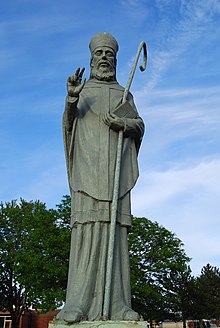
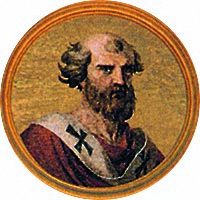





















.svg/100px-C_o_a_Clemente_VII_(Avignone).svg.png)
.svg/100px-C_o_a_Benedetto_XIII_(Avignone).svg.png)




.svg/100px-C_o_a_Alexandre_V_(Pisa).svg.png)


.svg/100px-C_o_a_Felice_V_(antipapa).svg.png)


















Bookmarks